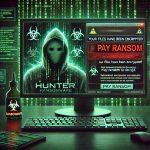RALord is a highly dangerous ransomware-type malware written in the Rust programming language. This file-encrypting malware not only locks victims out of their personal data but also threatens to leak stolen information if the ransom is not paid in a timely manner. Upon infecting a system, RALord appends the “.RALord” extension to encrypted files and drops a ransom note named README-[random_string].txt.
Like many modern ransomware variants, RALord targets both file confidentiality and integrity. Victims are pressured to act quickly, often within a day, to avoid data leakage. The ransom note provides a qTox contact ID and instructions for accessing communication portals through the Tor network. It also emphasizes that tampering with encrypted files could make recovery impossible.
RALord Ransomware Summary
| Attribute | Details |
|---|---|
| Threat Name | RALord |
| Threat Type | Ransomware, Crypto Virus, File Locker |
| Encrypted File Extension | .RALord |
| Ransom Note File Name | README-[random_string].txt |
| Associated Contact | qTox ID: 0C8E5B45C57AE244E9C904C5BC74F73306937469D9CEA22541CA69AC162B8D42A20F4C0382AC |
| Cybercriminal Websites | Access via Tor, URLs not specified |
| Detection Names | ESET-NOD32: A Variant Of Win64/Filecoder.UI Fortinet: W64/Filecoder.UI!tr Ikarus: Trojan.Crypter Malwarebytes: Ransom.RALord Symantec: ML.Attribute.HighConfidence |
| Symptoms of Infection | Inaccessible files with .RALord extension, ransom note displayed |
| Damage | Permanent file encryption, data theft, potential for data leakage |
| Distribution Methods | Malicious email attachments, torrents, fake software cracks, malvertising |
| Danger Level | High – encrypts and steals data, threatens leak, no known decryptor |
Text from README-[random_string].txt
shellCopyEdit------------------------------------ RALord ransomware ------------------------------------
-> Hello , without any problems , if you see this Readme its mean you under controll by RLord ransomware , the data has been stolen and everything done , but
-> you can recover the files by contact us and pay the ransom , the data taken from this device or network have crenditals and your systeminfo too , without talk about files
-> also , we will provide report with hack operation and how to fix errors and up your security
-----------------
>>> contact us here :
-> qtoxID: 0C8E5B45C57AE244E9C904C5BC74F73306937469D9CEA22541CA69AC162B8D42A20F4C0382AC
-----------------
>>> important notes :
-> please do not touch the files becouse we can't decrypt it if you touch it
-> please contact us today becouse the leak operation should start
-> in nigotable please make sure to accept our rules, its easy
-----------------
>>> our websites :
-> mirror 1 : -
-> mirror 2 : -
-> mirror 3 : -
-> to enter this URLs you need to download tor : hxxps://www.torproject.org/download/
------------------------------------ RALord ransomware ------------------------------------
Additional Information
RALord not only encrypts data but also exfiltrates sensitive information such as credentials and system info. This dual-threat behavior heightens the stakes for victims, often forcing corporate targets to choose between paying or risking public leaks.
Like most ransomware, decryption without cooperation from the attackers is unlikely, unless a fatal flaw in the encryption is discovered – which is rare. Also, paying the ransom does not guarantee decryption, making the situation even more critical.
Manual Ransomware Removal Process
Important: Manual removal is recommended only for experienced users, as incorrect actions can lead to data loss or incomplete removal of the ransomware. If unsure, consider the SpyHunter Removal Method for a guided, automated solution.
Step 1: Disconnect from the Internet
- Immediately disable Wi-Fi or unplug the Ethernet cable to prevent the ransomware from communicating with remote servers.
- This can prevent additional encryption or further infections.
Step 2: Boot into Safe Mode
For Windows Users
- Windows 10/11:
- Press Windows + R, type
msconfig, and press Enter. - Under the Boot tab, select Safe boot and check Network.
- Click Apply, then OK, and restart your PC.
- Press Windows + R, type
- Windows 7/8:
- Restart your PC and press F8 repeatedly before Windows starts.
- Select Safe Mode with Networking and press Enter.
For Mac Users
- Restart your Mac and hold the Shift key immediately after the startup chime.
- Release the key when the Apple logo appears.
- Your Mac will boot in Safe Mode.
Step 3: Identify and Terminate Malicious Processes
Windows
- Open Task Manager by pressing Ctrl + Shift + Esc.
- Look for unusual processes consuming high CPU or memory.
- Right-click on the suspicious process and select End Task.
Mac
- Open Activity Monitor (Finder > Applications > Utilities > Activity Monitor).
- Look for unknown or high-resource-consuming processes.
- Select the suspicious process and click Force Quit.
Step 4: Delete Ransomware Files
Windows
- Open File Explorer and navigate to:
C:\Users\[Your Username]\AppData\LocalC:\Users\[Your Username]\AppData\RoamingC:\Windows\System32
- Identify and delete suspicious files (randomly named or recently modified items).
- Clear temporary files:
- Press Windows + R, type
%temp%, and hit Enter. - Delete all files in the Temp folder.
- Press Windows + R, type
Mac
- Open Finder and select Go > Go to Folder.
- Type
~/Library/Application Supportand check for unfamiliar files or folders. - Remove unknown
.plistfiles from~/Library/LaunchAgents.
Step 5: Remove Ransomware Entries from Registry or System Settings
Windows
- Press Windows + R, type
regedit, and hit Enter. - Navigate to:
HKEY_CURRENT_USER\SoftwareHKEY_LOCAL_MACHINE\Software
- Identify and delete ransomware-related registry entries.
Mac
- Open System Preferences > Users & Groups.
- Select the Login Items tab and remove any unknown startup programs.
- Check
~/Library/Preferencesfor malicious settings.
Step 6: Restore System Using a Backup or Restore Point
Windows
- Press Windows + R, type
rstrui, and press Enter. - Choose a restore point from before the infection and proceed.
Mac
- Restart your Mac and enter macOS Utilities by holding Command + R.
- Select Restore from Time Machine Backup and restore a safe backup.
Step 7: Attempt to Decrypt Files
- Check No More Ransom (www.nomoreransom.org) for available decryption tools.
- If unavailable, restore files from backups.
Automated Ransomware Removal with SpyHunter
If manual removal is too complex or risky, SpyHunter offers a safer, automated method for detecting and removing ransomware.
Step 1: Download SpyHunter
- Get SpyHunter from the official Enigma Software website.
Step 2: Install SpyHunter
- Open the downloaded file (
SpyHunter-Installer.exeor.dmgfor Mac users). - Follow the installation prompts.
- Launch SpyHunter upon completion.
Step 3: Run a Full System Scan
- Click Start Scan Now to detect malware and ransomware.
- Wait for the scan to complete and review detected threats.
Step 4: Remove Detected Ransomware
- Click Fix Threats to remove identified ransomware components.
- SpyHunter will clean your system automatically.
Step 5: SpyHunter’s Custom Malware HelpDesk
- If ransomware persists, use SpyHunter’s Malware HelpDesk for custom malware fixes.
Step 6: Restore Files
- Use backups stored on external drives or cloud storage.
- If no backup is available, check No More Ransom for decryption tools.
Preventing Future Ransomware Attacks
- Keep backups: Use cloud storage or an external hard drive.
- Install a reliable security tool: SpyHunter offers real-time protection against malware.
- Enable Windows Defender or Mac security features for additional protection.
- Avoid phishing emails and unknown attachments.
- Regularly update Windows, macOS, and installed applications.




